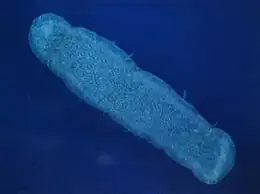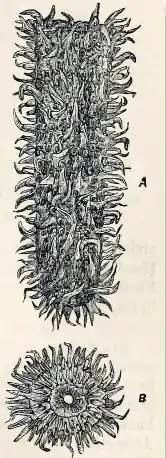| Pyrosoma atlanticum | |
|---|---|
 | |
| Pyrosoma atlanticum | |
| Scientific classification | |
| Domain: | Eukaryota |
| Kingdom: | Animalia |
| Phylum: | Chordata |
| Subphylum: | Tunicata |
| Class: | Thaliacea |
| Order: | Pyrosomida |
| Family: | Pyrosomatidae |
| Genus: | Pyrosoma |
| Species: | P. atlanticum |
| Binomial name | |
| Pyrosoma atlanticum | |
| Synonyms[1] | |
|
See list | |
Pyrosoma atlanticum is a pelagic species of marine colonial tunicate in the class Thaliacea found in temperate waters worldwide. The name of the genus comes from the Greek words pyros meaning 'fire' and soma meaning 'body', referring to the bright bioluminescence sometimes emitted.[2] The specific epithet atlanticum refers to the Atlantic Ocean, from where the first specimen of the species was collected for scientific description; it was described in 1804 by François Péron, a French naturalist.[1]
Description
.jpg.webp)
A colony of P. atlanticum is cylindrical and can grow up to 60 cm (2.0 ft) long and 4–6 cm (1.6–2.4 in) wide. The constituent zooids form a rigid tube, which may be pale pink, yellowish, or bluish. One end of the tube is narrower and is closed, while the other is open and has a strong diaphragm. The outer surface or test is gelatinised and dimpled with backward-pointing, blunt processes. The individual zooids are up to 8.5 mm (0.33 in) long and have a broad, rounded branchial sac with gill slits. Along the side of the branchial sac runs the endostyle, which produces mucus filters. Water is moved through the gill slits into the centre of the cylinder by cilia pulsating rhythmically. Plankton and other food particles are caught in mucus filters in the processes as the colony is propelled through the water. P. atlanticum is bioluminescent and can generate a brilliant blue-green light when stimulated.[2][3]
Distribution and habitat
P. atlanticum is found in temperate waters in all the world's oceans, usually between 50°N and 50°S. It is most plentiful at depths below 250 m (800 ft).[4] Colonies are pelagic and move through the water column.[2] They undergo a large diurnal migration, rising toward the surface in the evening and descending around dawn. Large colonies may rise through a vertical distance of 760 m (2,500 ft) daily, and even small colonies a few millimetres long can cover vertical distances of 90 m (300 ft).[5]
Biology
A study in the Indian Ocean comparing different zooplankton organisms found that colonies of P. atlanticum were the most efficient grazers of particles above 10 µm in diameter, catching a higher proportion of the particles than other grazers. This implies the species uses high biomass intake as a strategy, rather than investing in energy-conservation mechanisms.[6]
Growth occurs by new rings of zooids being budded off around the edge of the elongating colony. A pair of luminescent organs is on either side of the inlet siphon of each zooid. When stimulated, these turn on and off, causing rhythmic flashing. No neural pathway runs between the zooids, but each responds to the light produced by other individuals, and even by light from other nearby colonies.[7]
P. atlanticum remains as one of the least studied planktonic grazers, according to a 2021 study. In the study,[8] the researchers took samples of the pyrosome's microbiome. The results of the study found that a possible source of bioluminescence in P. atlanticum is the abundance of Photobacterium in its microbiome. However, there is still debate, as a 2020 study found a potential endogenous pyrosome luciferase in the organism's transcriptome homologous to Renilla luciferase (RLuc). Further study of the luciferase showed that it reacted with coelenterazine to produce light, much like RLuc.[9]
Ecology
Five specimens of the penaeid shrimp Funchalia were found living inside colonies of P. atlanticum. Other amphipods also lived there, including the hyperiids Phronima and Phronimella spp.[10]
Predators of P. atlanticum include various bony fishes, such as the spiky oreo, the big-eyed cardinalfish, and the pelagic butterfish, dolphins, and whales such as the sperm whale and giant beaked whale.[4][11][12]
Synonyms

- Dipleurosoma ellipticum Brooks, 1906 – genus transfer and junior synonym
- Pyrosoma atlanticum dipleurosoma Metcalf & Hopkins, 1919 – junior synonym
- Pyrosoma atlanticum echinatum Metcalf & Hopkins, 1919 – junior synonym
- Pyrosoma atlanticum f. elegans Lesueur, 1815 – junior synonym
- Pyrosoma atlanticum hawaiiense Metcalf & Hopkins, 1919 – junior synonym
- Pyrosoma atlanticum intermedium Metcalf & Hopkins, 1919 – junior synonym
- Pyrosoma atlanticum paradoxum Metcalf & Hopkins, 1919 – junior synonym
- Pyrosoma atlanticum triangulum Neumann, 1913 – junior synonym
- Pyrosoma atlanticum var. giganteum Lesueur, 1815 – junior synonym
- Pyrosoma atlanticum var. levatum Seeliger, 1895 – junior synonym
- Pyrosoma atlanticum var. tuberculosum Seeliger, 1895 – junior synonym
- Pyrosoma benthica Monniot C. & Monniot F., 1966 – junior synonym
- Pyrosoma elegans Lesueur, 1813 – junior synonym
- Pyrosoma ellipticum (Brooks, 1906) – junior synonym
- Pyrosoma giganteum Lesueur, 1815 – junior synonym
- Pyrosoma giganteum var. atlanticum Péron, 1804 – status change
- Pyrosoma rufum Quoy & Gaimard, 1824 – junior synonym
- Pyrosoma triangulum Neumann, 1909 – junior synonym
See also
References
- 1 2 3 Pyrosoma atlanticum - Péron, 1804 World Register of Marine Species. Retrieved 2011-11-10.
- 1 2 3 Pyrosoma atlanticum (Peron, 1804) : Pyrosome Archived 2011-11-15 at the Wayback Machine The JelliesZone. Retrieved 2011-11-10.
- ↑ Pyrosoma atlanticum Marine Species Identification Portal. Retrieved 2011-11-11.
- 1 2 Pyrosoma atlanticum - Péron, 1804 SeaLifeBase. Retrieved 2011-11-11.
- ↑ Andersen, Valérie & Jacques Sardou (1994). "Pyrosoma atlanticum (Tunicata, Thaliacea): diel migration and vertical distribution as a function of colony size". Journal of Plankton Research. 16 (4): 337–349. doi:10.1093/plankt/16.4.337.
- ↑ Perissinotto R.; P. Mayzaud; P. D. Nichols; J. P. Labat (2007). "Grazing by Pyrosoma atlanticum (Tunicata, Thaliacea) in the south Indian Ocean". Marine Ecology. 330: 1. Bibcode:2007MEPS..330....1P. doi:10.3354/meps330001. Retrieved 2011-11-12.
- ↑ Bowlby, Mark R.; Edith Widder; James Case (1990). "Patterns of stimulated bioluminescence in two pyrosomes (Tunicata: Pyrosomatidae)". Biological Bulletin. 179 (3): 340–350. doi:10.2307/1542326. JSTOR 1542326. PMID 29314963.
- ↑ Berger, Alexis; Blackwelder, Patricia; Frank, Tamara; Sutton, Tracy T.; Pruzinsky, Nina M.; Slayden, Natalie; Lopes, Jose V. (3 February 2021). "Microscopic and genetic characterization of bacterial symbionts with bioluminescent potential in Pyrosoma atlanticum". Frontiers in Marine Science. 8: 606818. doi:10.3389/fmars.2021.606818.
- ↑ Tessler, Michael; Gaffney, Jean P.; Oliveira, Anderson G.; Guarnaccia, Andrew; Dobi, Krista C.; Gujarati, Nehaben A.; Galbraith, Moira; Mirza, Jeremy D.; Sparks, John S.; Pieribone, Vincent A.; Wood, Robert J. (2020-10-20). "A putative chordate luciferase from a cosmopolitan tunicate indicates convergent bioluminescence evolution across phyla". Scientific Reports. 10 (1): 17724. Bibcode:2020NatSR..1017724T. doi:10.1038/s41598-020-73446-w. PMC 7576829. PMID 33082360.
- ↑ Lindlay, J. A.; et al. (2001). "Funchalia sp. (Crustacea: Penaeidae) associated with Pyrosoma (Thaliaceae: Pyrosomidae off the Canary Islands" (PDF). Journal of the Marine Biological Association of the United Kingdom. 81: 173–4. doi:10.1017/s0025315401003551. S2CID 84501250. Archived from the original (PDF) on 2012-04-15. Retrieved 2011-11-12.
- ↑ Chua, Marcus A.H.; Lane, David J.W.; Ooi, Seng Keat; Tay, Serene H.X.; Kubodera, Tsunemi (5 April 2019). "Diet and mitochondrial DNA haplotype of a sperm whale (Physeter macrocephalus) found dead off Jurong Island, Singapore". PeerJ. 7: e6705. doi:10.7717/peerj.6705. PMC 6452849. PMID 30984481.
- ↑ Walker, William A.; Mead, James G.; Brownell, Robert L. (October 2002). "Diets of Baird's beaked whales, Berardius bairdii, in the southern Sea of Okhotsk and off the Pacific coast of Honshu, Japan". Marine Mammal Science. 18 (4): 902–919. doi:10.1111/j.1748-7692.2002.tb01081.x.
External links
 Media related to Pyrosoma atlanticum at Wikimedia Commons
Media related to Pyrosoma atlanticum at Wikimedia Commons